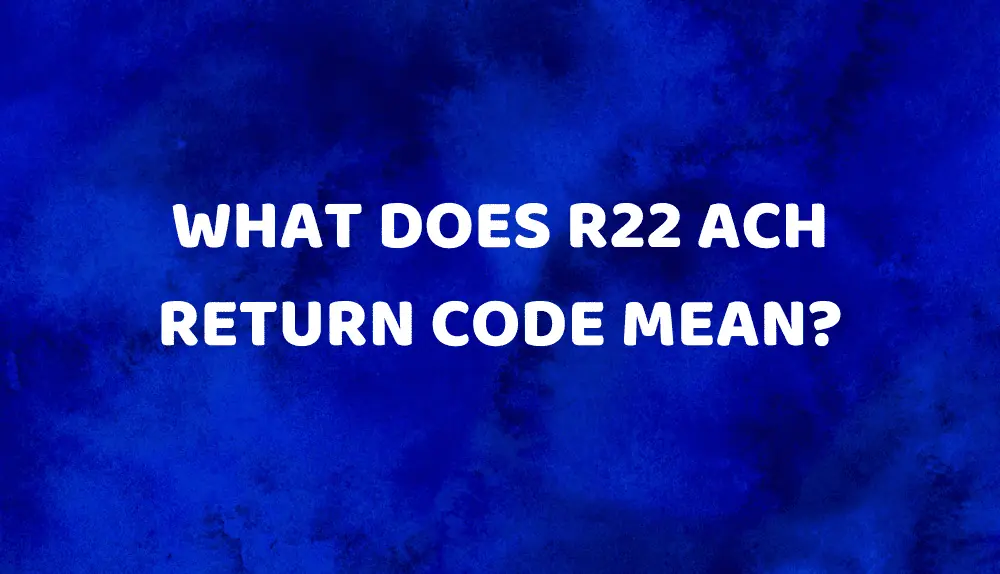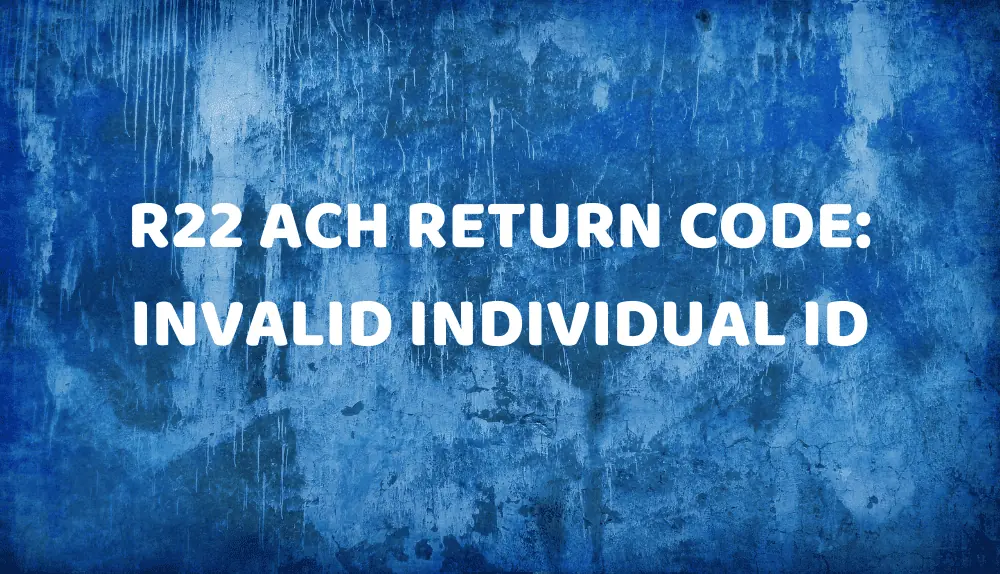When there is an invalid individual ID then it is represented by R22 ACH Return Code. This article explains the the meaning of R22 ACH return code as well as it causes and implications.
What Does R22 ACH Return Code Mean?

The ACH R22 return code carries significant implications for electronic payment transactions. When an ACH entry encounters an issue with the individual’s identification, the R22 code is used to signal that the Individual ID provided in the transaction is invalid or unrecognized.
This can happen when the ID is missing, incorrect, or doesn’t match the information on record with the receiving financial institution. The R22 return code serves as a protective measure to prevent erroneous transfers and unauthorized withdrawals, safeguarding both individuals and financial institutions from potential fraud and mistakes.
For the payer, encountering the ACH R22 return code may lead to a delayed or unsuccessful payment. It is essential to verify and double-check the accuracy of the recipient’s details before initiating an ACH transaction to avoid such occurrences. Conversely, for the payee, receiving an R22 return code prompts the need to update and correct their Individual ID information to ensure smooth and error-free future transactions. Understanding the significance of the ACH R22 return code is vital in maintaining the integrity and efficiency of electronic payment systems.
Reasons ACH R22 Return Code Can Occur

The ACH R22 return code is a vital aspect of the Automated Clearing House (ACH) network, a secure electronic payment system that facilitates fund transfers between financial institutions. When an ACH transaction encounters an issue with an individual’s identification, the R22 code is triggered, indicating that the Individual ID provided in the transaction is invalid or unrecognized. Several reasons can lead to the occurrence of the ACH R22 code, impacting both payers and payees in the process.
Inaccurate or Missing Information
One common reason for the ACH R22 return code is the presence of inaccurate or incomplete data in the transaction. If the Individual ID is mistyped or missing altogether, the receiving financial institution won’t be able to match the information to an existing account, resulting in the R22 code being applied. It is crucial for payers to double-check and verify all recipient details before initiating an ACH transfer to avoid such errors.
Outdated or Changed Account Information
Individuals may encounter the ACH R22 return code if their account information, including the Individual ID, has changed or is outdated. This can happen when a person switches banks, closes an account, or updates their personal information without informing the relevant parties involved in the transaction. It is essential for payees to keep their account information up-to-date with their financial institutions and notify relevant parties of any changes to avoid potential ACH issues.
Unauthorized Transactions
In some cases, the ACH R22 code may be triggered due to unauthorized transactions. If a payment is initiated using incorrect or unauthorized Individual ID information, the receiving financial institution will flag it with the R22 code to prevent fraudulent transfers. This safeguard protects individuals from potential financial losses and enhances the overall security of the ACH network.
Insufficient Account Balance
Insufficient funds in the recipient’s account can also lead to the ACH R22 return code. If the financial institution attempts to process a transaction, but the account balance is insufficient to cover the transfer, the R22 code will be applied, indicating the unsuccessful transaction.
The ACH R22 return code plays a crucial role in maintaining the security and efficiency of the ACH network. Understanding the various reasons that can lead to the occurrence of the ACH R22 code is essential for both payers and payees to ensure smooth and error-free electronic payment transactions. By verifying and updating account information regularly and exercising caution during transactions, individuals can help prevent the occurrence of the ACH R22 return code and enjoy the benefits of a reliable and secure electronic payment system.
Steps to Fix ACH R22 Return Code
Fixing the ACH R22 return code requires identifying and addressing the underlying issue that triggered the code in the first place. Below are the steps to rectify the ACH R22 return code:
Verify Recipient Information
Double-check and verify all recipient information, including the Individual ID, to ensure accuracy. Ensure that the information matches the details on record with the receiving financial institution. If there are any discrepancies, correct them before attempting the ACH transaction again.
Contact the Recipient
If you’re the payer and encounter the ACH R22 return code, consider contacting the recipient to confirm their account details. This step is crucial, especially if there have been recent changes to the recipient’s account information, such as a switch to a different bank or an update to their personal data.
Update Account Information
If you’re the payee and received the ACH R22 return code, promptly update your account information with your financial institution. Ensure that your Individual ID and other relevant details are accurate and up-to-date to avoid any further issues with future ACH transactions.
Check for Authorization
As a payer, ensure that you have the necessary authorization to make the ACH transaction. Confirm that you have permission to use the recipient’s account information and that the transaction aligns with any contractual agreements or mandates in place.
Sufficient Account Balance
If the ACH R22 return code is triggered due to insufficient funds in the recipient’s account, the payee must ensure that there are enough funds to cover the transaction. If necessary, coordinate with the recipient to arrange for the transfer when sufficient funds are available.
Review and Resubmit the Transaction
After addressing the underlying issue, review the ACH transaction details for accuracy once more. If everything checks out, resubmit the transaction through your financial institution. Ensure that you use the updated and correct recipient information to avoid encountering the ACH R22 return code again.
Monitor and Confirm
Monitor the transaction status and verify that the payment is successfully processed without any issues. Keep track of the payment confirmation and any subsequent notifications to ensure that the ACH R22 return code has been resolved satisfactorily.
By following these steps, you can effectively resolve the ACH R22 return code and enjoy smooth and successful electronic payment transactions going forward. If you continue to encounter the code despite these efforts, consider reaching out to your financial institution for further assistance and clarification.
How Can Businesses Deal With ACH R22 Return Code
Dealing with the ACH R22 return code can be a challenging task for businesses, but there are several steps they can take to effectively address and prevent its occurrence in the future. Here’s a guide on how businesses can handle the ACH R22 return code:
Review Transaction Details
Upon receiving the ACH R22 return code, businesses should first review the transaction details to identify the specific reason for the code. Check the recipient’s Individual ID, account information, and transaction amount for accuracy.
Contact the Recipient
If possible, get in touch with the recipient to verify their account information and ensure that it aligns with what was provided in the transaction. This step is especially important if there have been recent changes to the recipient’s account details.
Update Customer Information
Maintain up-to-date records of customer information, including Individual IDs and account details. Regularly review and update this information to minimize the risk of encountering the ACH R22 return code due to outdated or incorrect data.
Obtain Proper Authorization
Ensure that you have proper authorization from customers before initiating any ACH transactions on their behalf. Implement stringent processes to verify and document authorization to prevent unauthorized or erroneous payments.
Address Insufficient Funds
If the ACH R22 return code is triggered due to insufficient funds in the recipient’s account, communicate with the customer to arrange for a payment when sufficient funds are available. Implement measures to monitor account balances and avoid processing transactions when there are inadequate funds.
Use Fraud Prevention Measures
Implement robust fraud prevention measures to protect against unauthorized ACH transactions and potential misuse of customer account information. These measures may include multi-factor authentication, transaction monitoring, and verification processes.
Resubmit Corrected Transactions
After addressing the issue that led to the ACH R22 return code, resubmit the corrected transaction with accurate recipient information. Confirm that all necessary updates have been made before resubmitting the payment.
Monitor Transaction Status
Keep track of the transaction status to ensure that the resubmitted payment processes successfully without encountering the ACH R22 return code again. Implement a monitoring system to promptly identify and address any issues that arise during the transaction process.
Communicate with Financial Institutions
Maintain open lines of communication with the financial institutions involved in the ACH transactions. If the ACH R22 return code persists despite taking corrective measures, collaborate with the financial institution to understand the specific issue and seek guidance on resolving it.
By following these steps, businesses can effectively handle the ACH R22 return code, minimize its occurrence, and maintain a secure and efficient payment process for their customers. Regularly reviewing and updating customer information, obtaining proper authorization, and implementing fraud prevention measures are essential practices to ensure smooth ACH transactions and build trust with customers.
Final Words
ACH R22 return code carries significant implications for both individuals and businesses for electronic payment transactions. Understanding the reasons behind its occurrence is crucial for promptly addressing the underlying issues and ensuring the security and efficiency of the Automated Clearing House network.
Whether it stems from inaccurate information, outdated account details, insufficient funds, or unauthorized transactions, taking proactive steps to rectify and prevent the ACH R22 return code is essential. By maintaining accurate recipient information, obtaining proper authorization, implementing fraud prevention measures, and fostering clear communication with financial institutions, businesses can navigate the complexities of the ACH system successfully.
Embracing these practices not only mitigates the risks associated with the ACH R22 return code but also fosters trust and reliability in electronic payment processes, ultimately benefiting all stakeholders in the ever-evolving landscape of modern financial interactions.
Frequently Asked Questions (FAQs)
Why did I receive the ACH R22 return code on my transaction?
You might have received the ACH R22 return code if the recipient's Individual ID in the transaction was incorrect, missing, or outdated. It can also occur due to insufficient funds in the recipient's account or unauthorized use of account information.
How can I fix the ACH R22 return code issue?
To resolve the ACH R22 return code, verify the recipient's information for accuracy, including their Individual ID and account details. Update any outdated information and ensure you have proper authorization for the transaction. If the code is due to insufficient funds, arrange for the payment when sufficient funds are available.
Can the ACH R22 return code be prevented?
Yes, the ACH R22 return code can be prevented by maintaining accurate and up-to-date recipient information, obtaining proper authorization for transactions, and implementing fraud prevention measures. Regularly review and update customer records to reduce the risk of encountering the code.
What are some fraud prevention measures to avoid the ACH R22 return code?
Fraud prevention measures include multi-factor authentication, transaction monitoring, and verification processes. Businesses should implement these measures to protect against unauthorized ACH transactions and potential misuse of customer account information.
Can I resubmit the ACH transaction after receiving the ACH R22 return code?
Yes, after addressing the issue that triggered the ACH R22 return code, you can resubmit the corrected transaction with accurate recipient information. Ensure that all necessary updates have been made before resubmitting the payment.
What should I do if the ACH R22 return code persists despite taking corrective measures?
If the ACH R22 return code continues to appear despite taking corrective measures, it is essential to communicate with the financial institutions involved in the transaction. Collaborate with them to understand the specific issue and seek guidance on resolving it effectively.

